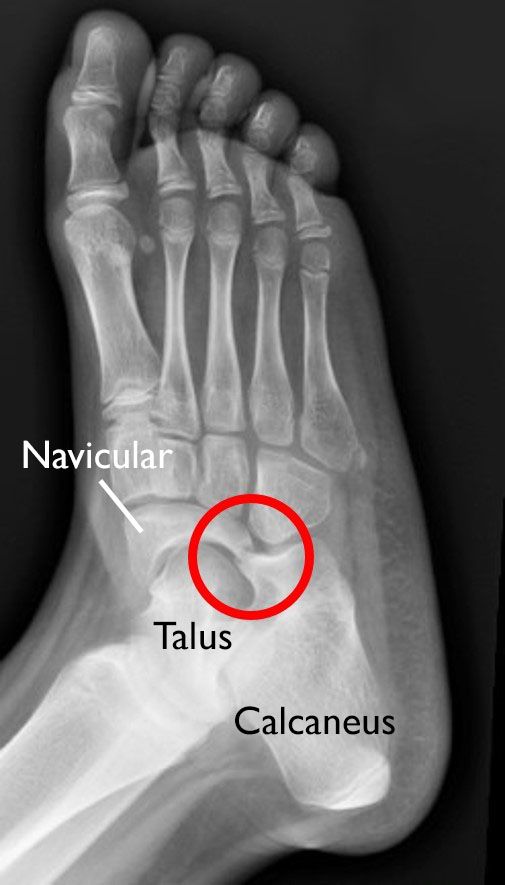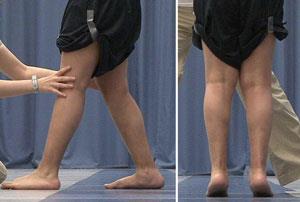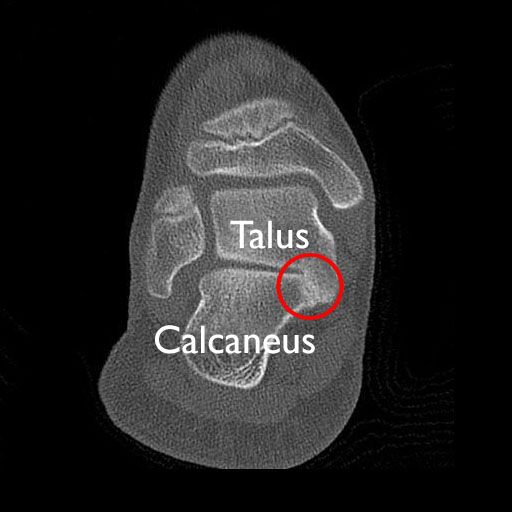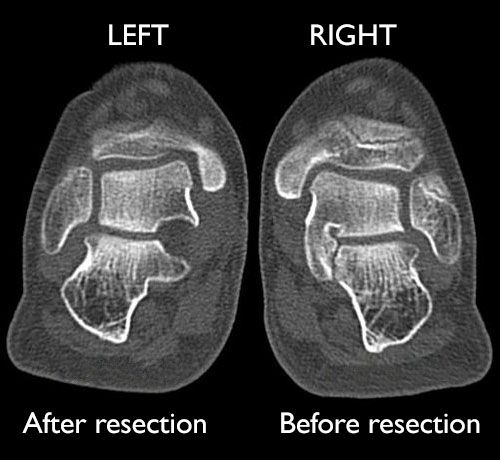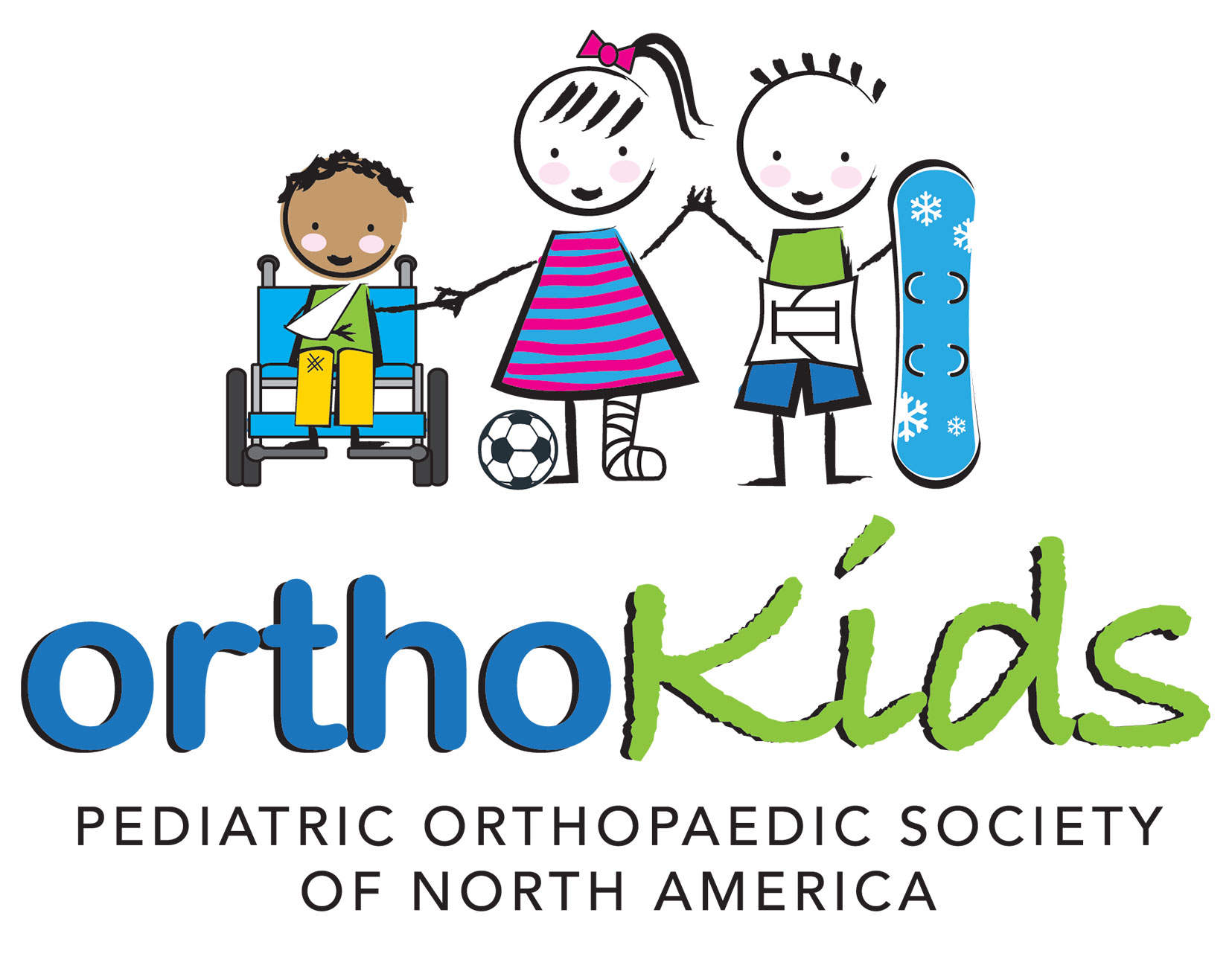Diseases & Conditions
Tarsal Coalition
A tarsal coalition is an abnormal connection of two or more bones in the foot. The bones affected — called tarsal bones — are located toward the back of the foot and in the heel, and the connection of the bones can result in a severe, rigid flatfoot.
Although tarsal coalition is often present at birth, children typically do not show signs of the disorder until early adolescence.
- Many children have this condition without knowing it and are able to run and play.
- However, in some children, the foot can become stiff and painful. This can cause symptoms ranging from mild pain to difficulty running and playing sports.
For many children with tarsal coalition, symptoms are relieved with simple treatments, like orthotics and physical therapy. If a child has severe symptoms that interfere with daily activities and that do not respond to simple treatments, surgery may be recommended.
Anatomy
The bones of the feet are commonly divided into three parts: the hindfoot, midfoot, and forefoot.
Seven bones — called tarsals — compose the hindfoot and midfoot. Coalitions can happen between any of the bones, but the calcaneus, talus, and navicular are most commonly involved in tarsal coalitions.
Description
In human development, the bones of the hindfoot are supposed to divide out into separate ones. However, this does not always happen, and a tarsal coalition occurs when two bones have an abnormal connection. This can be a bridge of bone, cartilage, or fibrous tissue. These bridges are often referred to as "bars" and they can cover just a small amount of the joint space between the bones, or a large portion of the space.
The two most common sites of tarsal coalition are:
- Between the calcaneus and navicular bones (calcaneonavicular coalition)
- Between the talus and calcaneus bones (talocalcaneal coalition)
However, other joints can also be affected.
It is estimated that one out of every 100 people may have a tarsal coalition. In about 50% of cases, both feet are affected. The exact number of people with the disorder is hard to determine because many coalitions never cause noticeable symptoms. In other words, there are many people who have this condition and do not know it.
Although the coalition forms before birth, its presence is usually not discovered until late childhood or adolescence. This is usually because the abnormal connection does not cause pain or symptoms until the child gets a little older.
In babies, the foot contains a higher percentage of soft, growing cartilage. As a child grows, this cartilage mineralizes (ossifies), resulting in hard, mature bone. If a coalition exists, it may harden, too, and fuse the growing bones together with a solid bridge of bone or fibrous tissue similar to a scar. The ossification of the coalition typically happens between ages 8 and 16, depending upon which bones are involved.
As the coalition turns to bone, the foot becomes stiffer and can start causing pain and other symptoms. Over time, the stiffness of the foot can lead to arthritis.
Symptoms
Many tarsal coalitions are never discovered because they do not cause symptoms or any obvious foot deformity. When symptoms do occur, they may include:
- Stiff, painful feet. The pain usually occurs below the ankle around the middle or back half of the foot.
- A rigid, flat foot that makes it difficult to walk on uneven surfaces. The ankle may have to roll more to make up for the lack of foot motion. This can cause repeated ankle sprains.
- Increased pain or a limp with higher levels of activity.
Doctor Examination
Medical History and Physical Examination
After discussing your symptoms and general health history, your child's doctor will do a complete examination of your child's foot and ankle, including foot flexibility and gait.
Patients with tarsal coalitions may have a flat arch that does not fully correct when pushing up on the toes and raising the heel.
Imaging Tests
To accurately diagnose the number, location and extent of the coalition(s), the doctor will order images of your child's foot and ankle.
- X-rays. X-rays provide clear images of bone. Many coalitions are visible on X-rays.
- Computed tomography (CT) scans. The images produced with computed tomography provide greater detail of the bones. CT scans are the gold standard for imaging tarsal coalitions because they can show more subtle bars that may be missed with plain X-rays.
- Magnetic resonance (MRI) scans. MRI scans provide detailed pictures that include soft tissues. The doctor may order this test to look for irregular bars formed from cartilage or fibrous tissue, which don't show up on X-rays or CT scans.
Treatment
Tarsal coalitions require treatment only if they are causing symptoms.
Nonsurgical Treatment
- Rest. Taking a break from high-impact activity for a period time — typically 3 to 6 weeks — can allow for inflammation and swelling to settle down and relieve pain.
- Orthotics. Arch supports, shoe inserts like heel cups and wedges, and other types of orthotics may be recommended to help stabilize the foot and relieve pain.
- Temporary boot or cast. These options can immobilize the foot (keep it from moving) and take stress off of the tarsal bones, allowing inflammation and swelling to calm.
- Injections. Steroid medications may be used to provide temporary pain relief by helping to decrease inflammation.
Surgical Treatment
When nonsurgical treatments are not effective at easing pain or improving function, your child's doctor may consider surgery.
The surgical procedure the doctor recommends will depend on the size and location of the coalition, and whether the joints between the bones show signs of arthritis.
- Resection (Removing the Coalition). In this procedure, the coalition is removed and replaced with muscle or fatty tissue from another area of the body. This is the most common surgery for tarsal coalition because it preserves normal foot motion and successfully relieves symptoms in most patients who do not have signs of arthritis.
- Flatfoot Reconstruction. Removal of the coalition alone does not correct the flat shape of the foot. If the flatness is severe enough to also cause symptoms, correction of foot alignment may also be done at the time of the coalition resection. This usually involves cutting and realigning the bones to rebuild an arch.
- Fusion. For larger, more severe coalitions that cause significant deformity and also involve arthritis, joint fusion may be needed. The goal of fusion is to limit movement of painful joints and place the bones in the proper position. In fusion for tarsal coalition, the bones may be held in place with large screws, pins, or screw-and-plate devices.
Recovery
- Depending on the type and location of the surgery, a cast will be required for a period of time to protect the surgical site and keep your child from putting weight on the foot.
- When the cast comes off, it will likely be replaced with a walking boot, and the doctor may recommend physical therapy exercises to begin restoring range of motion and strength. The doctor will determine when it is safe for your child to begin putting weight on the foot. Arch supports or orthotics may also be helpful in supporting the foot joints, even after surgery.
- Although it may take several months to fully recover, most patients experience pain relief after surgery.
Contributed and/or Updated by
Peer-Reviewed by
AAOS does not endorse any treatments, procedures, products, or physicians referenced herein. This information is provided as an educational service and is not intended to serve as medical advice. Anyone seeking specific orthopaedic advice or assistance should consult his or her orthopaedic surgeon, or locate one in your area through the AAOS Find an Orthopaedist program on this website.








